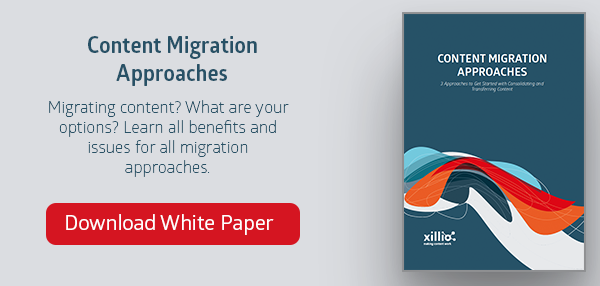6 Reasons for Failing Content Migrations
by Sjoerd Alkema, on Mar 7, 2017 3:18:43 PM
Our migration services team is often asked to join a project during a critical stage of its implementation, when the migration has already failed and has formed a bottleneck that impedes the success of the overall project. Sometimes we also are asked, after a project, to improve the migration or even to perform the migration again. Because of this, I’ve decided to list the following six most common reasons for failed content migrations:

1. Standard boxed solution
There are a lot of 'off the shelf' solutions for most known migrations; think of file share or SharePoint. These are good solutions, but only for limited use case. Using these, you may find that there is still an additional desire or requirement needed that does not fit into these standards. This often leads to customization, with all the risks that process can entail.
- 2. Build it yourself
Many organizations see a migration as something that can be built by their own internal IT department. Of course this is possible, but the results are almost always disappointing and can lead to a solution that doesn’t allow for an audit trail, or requires extensive logging capabilities and opportunities to enrich content later. A content migration is more than just moving content from A to B.
- 3. Last moment
Implementing a new system can be an important strategic choice. When taken, the focus is on the new features and the solution’s implementation, and organizational leaders do not usually think about transferring the existing data and content to the new system. This can result in budgets that are no longer adequate and migrations that don’t get completed in the agreed upon time frame, or migrations that lack quality and acceptance. During the planning phase, the actual migration should be included before you even begin to start the project.
- 4. No analysis
A migration project often starts with the sole principle that content must be migrated. What content exactly and how long this will take -- and what should be done to enrich the content -- is not always analyzed. The results, therefore, turn out to be less positive than expected. A perfect start for a migration is an analysis of all content.
- 5. Users are not involved enough
Essential in any IT project, but certainly in a migration project, is the involvement of users. A migration is a great opportunity to take a closer look at your data or content. For this, you need input from the business. For example, if something is still valuable, where should this content be placed in the new structure? Also, users are required for the acceptance. 'Garbage in' means an even bigger 'garbage out' in the new system. This is because it does not fit into the new structure and it loses context with respect to the source system. This leads to content not being able to be found, inefficiency and, in general, very poor adoption of the new system.
- 6. No selection or enrichment
A migration is an excellent opportunity to analyze the content on value and to enrich it when necessary. Grab this chance, for example, to add metadata, to filter out old files, to delete duplicates and identify versions. If you do not, chances are that the new system will start with a backlog and will never fully accepted.
So how do you ensure that a content migration is successful? Start by thinking about the migration time line and beginning with an analysis of quantity and quality of the resources. Also, make sure that a flexible, yet sturdy, solution is used to migrate the data – one that offers the possibility to apply business rules and intelligence for selection and enrichment of the content.
-----------------------------------------------------------------------------------------
5 Approaches to Consolidate and Migrate Content
Finaly decided to get started with a content migration? Or to replace your file shares with an central ECM system? Then there are 5 approaches you can use for the actual migration. Download the whitepaper to learn more.





%20(300%20x%2060%20px)%20(3).png?width=635&height=127&name=ISO%20email%20signature%20(390%20x%2060%20px)%20(300%20x%2060%20px)%20(3).png)